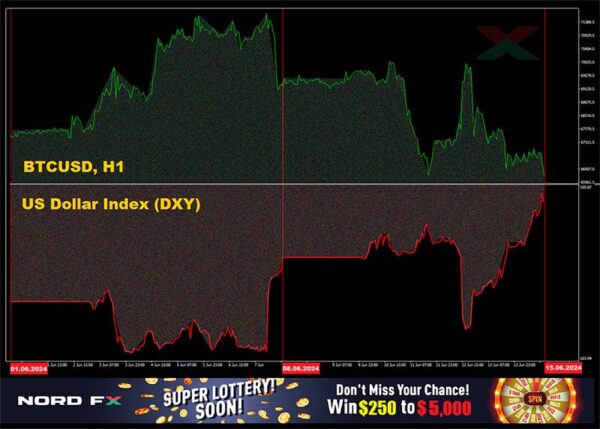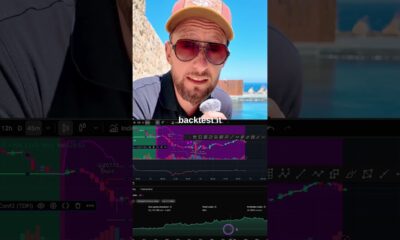News
Forex and Cryptocurrency Forecast – Action Forex

EUR/USD: Hawkish Sentiments of the Fed
As expected, the key day of last week was Wednesday, 12 June. After the publication of inflation data in the USA, the dollar came under strong pressure. Fresh figures showed that in May, the overall inflation rate (CPI) in annual terms decreased to 3.3% compared to the expected 3.4%. On a monthly basis, the indicator dropped from 0.3% to 0% against the forecast of 0.1%. The Core Consumer Price Index (Core CPI), which does not take into account food and energy prices, was 0.2% (m/m) compared to April, which was below the forecast of 0.3%. Annually, this index grew by 3.4%, showing the slowest growth rate in the last three years (previous value 3.6%, forecast 3.5%).
This cooling of inflation increased market participants’ expectations that the Fed might lower the interest rate twice this year, with the first stage of monetary policy easing occurring as early as September. As a result, the Dollar Index (DXY) fell from 105.3 to 104.3, and EUR/USD soared by more than 100 points, reaching a local high of 1.0851.
However, the bears’ joy regarding the dollar was short-lived. The results of the FOMC (Federal Open Market Committee) meeting of the US Federal Reserve returned the DXY to its starting point. The key interest rate was predictably left unchanged at 5.50%. At the same time, the new median forecast of FOMC members showed that the regulator confidently expects only one rate cut in 2024. Recall that in March, the Fed predicted three cuts in 2024 and three in 2025. Now, 15 out of 19 Fed leaders expect at least one or two cuts this year (7 for 25 basis points, 8 for 50 basis points), while the remaining 4 forecast the start of easing (QE) no earlier than 2025. Currently, CME Group’s FedWatch indicates almost a 70% probability of the start of QE at the September FOMC meeting.
Fed Chair Jerome Powell noted at the post-meeting press conference that the US labour market remains generally strong, although not overheated. The US economy continues to grow at a confident pace. According to him, further actions will depend on the balance of risks at each meeting. The Fed does not intend to allow a labour market collapse as a means of reducing inflation. If the economy remains resilient and inflation stable, the Fed is ready to maintain the current rate level for as long as necessary. If the labour market weakens or inflation falls faster than expected, the US central bank is ready to respond with a rate cut. At the same time, Powell noted that the regulator needs to see more “good data” to be confident in the sustainable movement of inflation towards the target level of 2.0%. Additionally, he warned markets against excessive expectations regarding the supposed monetary policy easing, adding that a single rate cut of 25 basis points will not have a significant impact on the economy.
Powell’s rather hawkish rhetoric was reinforced by the publication of new medium-term economic forecasts presented by the Fed following the meeting. Thus, the regulator raised the inflation forecast for 2024 to 2.6% from 2.4%, and for 2025 to 2.3% from 2.2%. The Fed hopes to return inflation to the target 2.0% only in 2026. The US GDP growth forecast remained unchanged throughout the forecast horizon – at 2.1% in 2024-2026. The Fed also kept the unemployment forecast in the US at 4.0% in 2024, increasing it to 4.2% from 4.1% in 2025, and to 4.1% from 4.0% in 2026.
Besides this hawkish revision of the US central bank’s economic forecasts, the dollar’s further strengthening was facilitated by its role as a safe-haven currency. The future of the euro remains in question against the backdrop of political uncertainty in the Eurozone. On Sunday, 9 June, the results of the European Parliament elections, which shocked many, were announced: in Germany, France, and Belgium, far-right parties won while ruling parties suffered defeats. In France, President Emmanuel Macron’s party garnered only 14.5% of the votes, resulting in the dissolution of the National Assembly and the appointment of early elections. Some market participants believe that political risks may send EUR/USD to the 1.0600 area or even lower in the coming weeks.
The weakening of the euro will also be facilitated by the fact that the European Central Bank has already begun a cycle of rate cuts. On Thursday, 6 June, the ECB Governing Council cut the key interest rate by 25 basis points to 4.25%. Since September 2023, inflation in the Eurozone has decreased by more than 2.5%, allowing the regulator to take such a step for the first time in a long while. Additionally, fresh macroeconomic data show that the target level of 2.0% may be achieved quite soon. For instance, the German CPI, the locomotive of the European economy, published on Wednesday, 12 June, showed a decline from 0.5% to 0.1% (m/m). ECB representative Bostjan Vasle stated on Thursday that “further rate cuts are possible if the disinflation process continues.”
The last chord of the past week saw EUR/USD at 1.0702. As for the forecast of analysts for the near future, as of the evening of 14 June, 60% of their votes were given for the pair’s decline, 20% for its rise, and 20% remained neutral. As for technical analysis, 100% of trend indicators and oscillators on D1 sided with the dollar, all coloured red, although 20% of the latter are in the oversold zone. The nearest support for the pair lies in the 1.0670 zone, followed by 1.0600-1.0620, 1.0560, 1.0495-1.0515, 1.0450, 1.0370. Resistance zones are in the areas of 1.0740, then 1.0780-1.0810, 1.0865-1.0895, 1.0925-1.0940, 1.0980-1.1010, 1.1050, 1.1100-1.1140.
In the coming week, on Tuesday, 18 June, it will be known what is happening with inflation (CPI) in the Eurozone, and statistics on the US retail market will also be released. On Wednesday, 19 June, it will be a holiday in the United States: the country celebrates Juneteenth. On Thursday, 20 June, the number of initial jobless claims in the US will be known, and the Philadelphia Fed Manufacturing Index will also be published. And at the very end of the workweek, on Friday, 21 June, a whole series of preliminary business activity (PMI) data will be received in various sectors of the German, Eurozone, and US economies. The publication of the Fed’s Monetary Policy Report on the same day will also attract considerable interest.
GBP/USD: What Will the Bank of England Decide on 20 June?
In autumn 2023, the BoE concluded that its monetary policy should remain tight for a prolonged period until inflation confidently stabilises at the target level of 2.0%. Based on this, despite a decrease in price pressure, at its meeting on 8 May, the Bank of England’s Monetary Policy Committee (MPC) decided by a majority vote (seven to two) to keep the key interest rate at the previous level of 5.25%. (Two MPC members voted for a reduction to 5.0%).
According to the country’s Office for National Statistics (ONS), since November 2022, the Consumer Price Index (CPI) has fallen from 11.1% to 2.3% – the lowest level since July 2021. The British central bank expects this figure to return to the target level in the near future but to increase slightly to around 2.5% in the second half of the year due to rising energy prices. Additionally, according to the May forecasts, CPI will be 1.9% in two years (Q2 2026) and 1.6% in three years (Q2 2027).
British inflation expectations for the near future have also decreased to the lowest level in almost three years, indicating a return to historically average levels. In May, the country’s residents on average expected consumer prices to rise by 2.8% over the next 12 months, compared to a forecast of around 3% in February. This is stated in the results of the British central bank’s quarterly survey.
Data on business activity (PMI) published in the first week of June indicated that the economy in the United Kingdom is relatively well. Activity in the manufacturing sector rose to 51.2 from 49.1 earlier. Some slowdown was shown by the PMI for the services sector – from 55.0 to 52.9, and the composite PMI – from 54.1 to 53.0. However, despite this, all these indicators remain above the 50.0 mark, separating growth from a slowdown in activity.
Certain concerns are raised by the UK labour market. Statistics published in early June showed a spike in jobless claims – by 50.4K in May after 8.4K the previous month. This is the largest monthly increase since the first COVID lockdowns. Before the pandemic, the last such spike was during the 2009 recession. Moreover, the unemployment rate for the February-April 2024 period rose to 4.4%. Of course, historically, this is a low level, but it is the highest in three years.
The next Bank of England meeting will be held on Thursday, 20 June. Analysts generally forecast that the interest rate will remain unchanged at 5.25%. This forecast is supported by the slowdown in inflation decline rates. Additionally, there is a significant increase in UK wages (+6.0%), which could push prices up. This, in turn, reduces the likelihood of the British central bank transitioning to a softer monetary policy in the near future. The start of QE may be delayed until September or later.
The BoE’s tight monetary policy creates prerequisites for future demand for the pound. Meanwhile, last week, GBP/USD was driven by overseas data. On US inflation data, it broke through the upper boundary of the 1.2700-1.2800 channel and rose to 1.2860, then, following the FOMC meeting results, it fell and broke through the lower boundary, dropping to 1.2656. The week ended at 1.2686.
The median forecast of analysts for the near term is somewhat similar to the forecast for the previous pair. In this case, 50% of specialists voted for dollar strengthening, 25% for a northern trajectory, and 25% remained neutral. As for technical analysis on D1, the picture is also mixed. Trend indicators are evenly split 50:50 between red and green. Among oscillators, 60% point south (a quarter signal oversold), 20% look north, and the remaining 20% remain neutral. In case of further pair decline, support levels and zones are 1.2575-1.2600, 1.2540, 1.2445-1.2465, 1.2405, 1.2300-1.2330. In case of pair growth, resistance will be encountered at 1.2760, 1.2800-1.2820, 1.2865-1.2900.
Besides the mentioned Bank of England meeting on 20 June, including its interest rate decision and subsequent press conference, it is necessary to note Wednesday, 19 June, when fresh consumer inflation (CPI) data for the UK will be released. Friday, 21 June, also promises to be interesting. On this day, retail sales volumes and preliminary business activity (PMI) indicators in various sectors of the UK’s economy will be known.
USD/JPY: BoJ Changed Nothing but Promised Changes in the Future
Unlike the Bank of England, the Bank of Japan (BoJ) meeting has already taken place, and its results were announced last Friday, 14 June. The yen’s weakness in recent months has negatively impacted Asian currencies. In March, the central bank made its first move – raising the rate for the first time since 2007 (since 2016, it had kept it at a negative level of -0.1%). The regulator also abandoned the targeting of 10-year government bond yields. Investors closely watched the Japanese central bank for hints on whether it would further unwind monetary stimulus.
But for now, the BoJ decided not to change its accommodative monetary policy, maintaining the current pace of bond purchases at around 6 trillion yen ($38 billion) per month. However, it promised to present a plan for their gradual reduction at the next meeting in July. “We decided to subsequently reduce the volume of our purchases [within one to two years] to ensure more free formation of long-term interest rates in financial markets,” the central bank statement said. At the same time, the regulator announced that it would gather market participants’ opinions before making a specific decision.
The deposit rate for commercial banks was also left unchanged – officials unanimously voted to keep it in the range of 0.0%-0.1%, as expected. From this, experts once again concluded that the BoJ would not rush to tighten its quantitative easing (QT) monetary policy.
The French bank Societe Generale believes that given the pressure from the government due to the weak yen, the most likely scenario will be a reduction in bond purchases starting in August, with their purchases decreasing every three months and reaching zero by November 2025. Additionally, according to Societe Generale economists, the BoJ may raise the discount rate in September this year.
Of course, USD/JPY could not ignore such events of the past week as the US CPI figures and the Fed meeting: its fluctuation range exceeded 240 points (155.71 at the low, 158.25 at the high). However, the five-day result was not so impressive: starting at 156.75, it ended at 157.37.
Experts’ forecasts for the near term look like this: not a single vote was given for the pair’s southern movement and yen strengthening, while the remaining votes were evenly split: 50% pointed north, and 50% remained neutral. As for technical analysis, all trend indicators on D1 are coloured green. The nearest support level is in the 156.80-157.05 zone, followed by 156.00-156.10, 155.45, 154.50-154.70, 153.10-153.60, 151.85-152.15, 150.80-151.00, 149.70-150.00, 148.40, 147.30-147.60, 146.50. The nearest resistance lies in the 157.70 area, followed by 158.25-158.60, 160.00-160.20.
No significant economic statistics releases for Japan are scheduled for the upcoming week.
CRYPTOCURRENCIES: The Present and Future of Bitcoin Depend on the USA
In the absence of independent drivers, the crypto market has recently followed the dollar, which in turn follows the Fed, which follows the macro statistics from the USA. BTC/USD is like scales, with the main cryptocurrency on one side and the US dollar on the other. The dollar became heavier – bitcoin became lighter, and vice versa. On Friday, 7 June, strong statistics on the US labour market were released – the dollar became heavier, bitcoin lighter. On Wednesday, 12 June, it turned out that inflation in the USA was decreasing – the dollar weakened, bitcoin became heavier. And in the evening, the Fed calmed the markets regarding the interest rate – and the scales swung back. Just look at the BTC/USD and Dollar Index (DXY) charts – the inverse correlation leaves no doubt.
In recent days, the flagship of the crypto market has lost about 7% in price. And the reason for this is the aforementioned monetary policy of the US Fed. Enthusiasm was not added by the fact that bitcoin-ETF inflows broke a 19-day streak. On 11 June alone, industry funds lost almost $65 million. The reasons are the same. They can be supplemented by the upcoming summer holiday season – a period of correction and lull in financial markets.
Traders note that recently, “digital gold” has been trading in a narrow range between $66,000 and $72,000. One of the popular market participants considers the lower mark an ideal entry point, while entry at the upper boundary of the range, in his words, carries high risk. MN Capital founder and analyst Michael van de Poppe does not rule out that pressure from sellers will persist in the near future. In such conditions, bitcoin may correct to $65,000 and even lower. However, van de Poppe does not expect a deep price drop. According to him, a large amount of liquidity is concentrated around the $60,000 area. This suggests that this level now acts as a strong support area, and positive dynamics can be supported by geopolitical instability.
According to surveys, more than 70% of the crypto community believe that BTC is on the verge of further growth. For instance, trader Captain Faibik is confident that bitcoin is preparing to break through the “expanding wedge” technical analysis pattern. According to him, breaking its upper boundary will open the path for the cryptocurrency to rise above $94,000. Trader Titan of Crypto, in turn, expects bitcoin to reach $100,000 this summer. The growth prospects of BTC are also indicated by the activity of large investors. According to industry representatives, whales are actively entering long positions on bitcoin. Cryptoquant CEO Ki Young Ju clarified that the $69,000 level has become particularly attractive for large investors.
New Binance CEO Richard Teng, who replaced Changpeng Zhao, believes that bitcoin will soon exceed $80,000. Teng associates the potential new high with the work of spot BTC-ETFs, which have strengthened trust in the asset. The Binance CEO also allows for the legalisation of cryptocurrency if Donald Trump is elected President of the United States. Declaring himself the “crypto president,” Trump said in May that the USA should lead the global crypto industry.
However, at present, cryptocurrency regulation measures are in the stage of development and implementation, which restrains investments. According to experts, current investments should be considered test cases. It should also be noted that spot ETFs have attracted significant liquidity only in the USA – there is no similar interest in most countries.
According to billionaire Mark Cuban, the attitude towards cryptocurrencies will be a key difference between US presidential candidates Donald Trump and Joe Biden, although neither understands this issue. “Do you really think [Trump] understands anything about cryptography other than making money from selling NFTs?” Cuban asked. And he answered himself: “Neither of [the candidates] understands. But I’ve said many times that Biden will have to choose between [SEC Chair] Gary Gensler and crypto-voters, otherwise it could cost him the White House.”
According to Bitfinex crypto exchange analysts, bitcoin’s price could rise to $120,000-125,000 within a few months to half a year. Similar figures are named by BitGo crypto trust company CEO Mike Belshe. In his opinion, by the end of 2024, the first cryptocurrency will cost $125,000-135,000, and one of the catalysts will be the high level of US government debt. “Our macroeconomic climate continues to confirm the need for bitcoin. Undoubtedly, US government debt is out of control. […] This situation supports the idea that bitcoin is the gold of the new generation,” Belshe said.
He also noted that the US dollar is losing its position as the world reserve currency due to US foreign policy. The BitGo CEO believes that the country uses the dollar as a weapon and a means of manipulation. “Thus, the US debt crisis is one, foreign policy and sanction control is two. And BRICS offers alternative payment systems. […] This is the story of why bitcoin exists,” he concluded.
At the time of writing this review on the evening of Friday, 14 June, BTC/USD is trading at $65,800. The total crypto market capitalisation is $2.38 trillion ($2.54 trillion a week ago). Bitcoin’s capitalisation has reached a solid $1.30 trillion, which, as experts warn, reduces the effect of future inflows. Pessimists say the asset is already “overheated,” and to reach $125,000, its capitalisation must almost double. In their opinion, such a colossal influx during the overbought period is unlikely, so one should expect a correction and subsequent consolidation. The possibility of such an outcome is also hinted at by the Bitcoin Fear & Greed Index: over 7 days, it fell from 77 to 70 points and moved from the Extreme-Greed zone to the Greed zones.
News
US Cryptocurrency Rules Delayed by ‘Never-Ending’ Lawsuits

Ripple CEO says cryptocurrency industry still seeking regulatory clarity from US
Speaking to Bloomberg News on Wednesday (July 17), Author: Brad Garlinghouse he said America is behind behind other countries which have already adopted cryptocurrency regulations.
“What we’re seeing, where it’s the UK, Japan, Singapore… even the European Union, more than two dozen countries have come together to provide a framework for cryptocurrency regulation,” Garlinghouse said.
“It’s frustrating that we as a country can’t get that regulatory framework in place. And instead, we have this never-ending lawsuit coming from the SEC that doesn’t really address the problem.”
Ripple has been the target of some of these legal disputes. Securities and Exchange Commission (SEC) sued the company in 2020, accusing it of conducting a $1.3 billion operation offering of unregistered securities tied to its XRP token.
However, last year a judge ruled that only Ripple’s institutional sales of XRP, not retail sales, violated the law, a decision widely seen as a victory for the cryptocurrency industry.
As PYMNTS noted at the time, that ruling has “far-reaching repercussions impact across the digital asset ecosystem, which has long maintained that its tokens do not represent securities contracts.”
However, Garlinghouse told Bloomberg on Wednesday that the company cannot wage multimillion-dollar legal battles over each token.
He spoke to the news agency from the Republican National Convention in Milwaukee, where the party is backing the candidacies of former President Donald Trump and Ohio Sen. J.D. Vance, both of whom are considered pro-cryptocurrency.
But Garlinghouse argued that cryptocurrencies “should not be a partisan issue,” and noted that he had recently attended a conference in Washington that included Democrats, including White House officials.
“I think they were there, listening to the industry… it was refreshing to start having that conversation,” she said.
President Joe Biden earlier this year he vetoed a measure which would have ended the SEC’s special rules for crypto-asset custodians. This legislation was supported by both the digital asset industry and the banking industry.
Ripple early this year donated $25 million to the cryptocurrency industry’s super PAC Fair Smoothiewith Garlinghouse stating at the time that such donations would continue every year, as long as the industry had its detractors.
Second Open SecretsWhich monitor spending For campaigns, the PAC has spent $13.4 million this year, much of it to help defeat Rep. Katie Porter’s (D-Calif.) U.S. Senate campaign.
News
The Future of Cybersecurity in the Cryptocurrency Industry

The cryptocurrency space has had a tumultuous journey, with its fair share of ups and downs. As we look to the future, one area that remains a constant focus is cybersecurity. The digital nature of cryptocurrencies makes them inherently vulnerable to cyber threats, and as the industry evolves, so does the landscape of potential risks.
In 2022, the cryptocurrency market faced significant challenges, with over $2 trillion in market value lost. This event served as a wake-up call for the industry, highlighting the need for robust cybersecurity measures. The future of cryptocurrency security is expected to see a shift towards more regulated and established institutions taking the reins of crypto technology and blockchain infrastructure.
The decentralized nature of cryptocurrencies offers numerous benefits, such as transparency and financial inclusion. However, it also introduces unique security challenges. The risk landscape is filled with threats such as hacking, phishing, ransomware attacks, malware, and social engineering. These threats not only lead to financial losses, but also damage the reputation and trust within the cryptocurrency ecosystem.
Mini-MBA Tekedia edition 15 ((September 9 – December 7, 2024) started recordings; Register today for discounts reserved for early bird customers.
Tekedia AI in Business Masterclass Opens registrations Here.
Join the Tekedia Capital Syndicate and IInvest in Africa’s best startups Here.
The decentralized nature of cryptocurrencies offers many benefits, but it also presents unique security challenges. Cyber risks such as hacking, phishing, and ransomware pose threats to the integrity of digital assets. The infrastructure that supports cryptocurrencies is not immune to vulnerabilities, including smart contract flaws and exchange hacks.
To address these vulnerabilities, the infrastructure that supports cryptocurrencies must be strengthened. Smart contract vulnerabilities, exchange hacks, wallet breaches, and flaws in the underlying blockchain technology are significant concerns that must be addressed to ensure the security and integrity of digital assets.
As cybercriminal tactics and techniques become more sophisticated, the cryptocurrency industry must stay ahead of the curve. The future will likely see more targeted attacks, exploiting weaknesses in infrastructure, networks, and human factors. This requires a proactive and multifaceted approach to cybersecurity.
To mitigate these risks, several measures must be adopted:
Strengthening security measures: Developers, exchanges, and wallet providers must improve security protocols, use strong encryption, implement multi-factor authentication, and conduct regular security audits.
Education and awareness: Users should be educated on best practices for protecting their digital assets, including using strong passwords, recognizing phishing attempts, and using hardware wallets for secure storage.
Looking ahead, the cryptocurrency industry is expected to see an increased focus on robust security measures. Blockchain projects and exchanges are likely to invest in advanced encryption techniques and decentralized storage solutions to protect user assets. The future impact of cyber risk on cryptocurrencies will depend on the collective efforts of stakeholders to address vulnerabilities and strengthen security measures.
Collective efforts by stakeholders in the cryptocurrency space are crucial to address vulnerabilities and strengthen security measures. While challenges persist, advances in cybersecurity technologies and practices offer hope for a more secure and resilient cryptocurrency ecosystem.
The future of cybersecurity in the cryptocurrency industry depends on finding a balance between innovation and regulation. It requires a collaborative effort from all parties involved, from developers to end users, to create a secure environment that fosters trust and growth in the industry. As we move forward, it is critical that lessons learned from past events guide the development of stronger security measures, ensuring the longevity and stability of cryptocurrencies as a vital part of the modern economic toolkit.
Like this:
Like Loading…
News
Bullish XRP and RLBK price predictions rise, outpacing the broader cryptocurrency market, prompting Shiba Inu holders to switch!

Bitcoin’s one-week surge from $60,000 has pushed other cryptocurrencies into an uptrend. However, for many altcoins, this trend has been temporary. Altcoins such as XRP and Shiba Inu (SHIB) have experienced price drops. However, Rollblock, a new altcoin on the Ethereum blockchain, has thrived during this period, attracting thousands of investors looking for long-term growth.
XRP’s Nearly 30% Growth Over Last Week Drops as Selling Pressure Increases
XRP is seeing further price decline as Ripple investors withdraw their profits from the token. The surge in XRP’s price to $0.64 in the past week has provided investors with a perfect opportunity to increase their returns in the short term. With the ongoing sell-off in XRP, XRP has jumped over 8% in the past day and is now trading at $0.59. However, analysts tracking XRP indicators predict that XRP could still extend its gains by over 30% in the coming weeks.
Shiba Inu (SHIB) marks its third consecutive day of losses
Shiba Inu (SHIB) is in a period of adjustment after a week of strong gains. In the last 24 hours, SHIB has seen a jump of over 7%, reflecting a natural market fluctuation. Analysts are observing a death cross on the Shiba Inu chart, which historically signals the potential for future opportunities as the market stabilizes. As investors explore new possibilities, some are diversifying into promising altcoins like Rollblock (RBLK) to strategically rebalance their portfolios and capitalize on the emerging trend.
Rollblock (RBLK) Up Another 7% as New Investors Join Pre-Sale
Rollblock (RBLK) has taken the cryptocurrency market by storm, having attracted investors from more popular altcoins like Shiba Inu (SHIB) and XRP. Rollblock’s growth is attributed to its utility in the $450 billion global gaming industry.
Rollblock aims to use blockchain technology to bridge the gap between centralized and decentralized gambling. With blockchain technology, Rollblock secures every transaction in its online casino, providing transparency and convenience to millions of players who are uncomfortable placing bets on other iGaming platforms.
This innovative use of blockchain technology in the industry has grown Rollblock to over 4,000 new users in less than two months. With plans to add sports betting, this number is expected to grow exponentially in Q3.
Rollblock uses a revenue sharing model that splits up to 30% of its casino’s weekly profits with token holders. This happens after Rollblock buys back $RBLK from the open market and uses half of it for rewards. The other half is burned to increase the price of $RBLK.
Rollblock price has seen four increases in the past month with $RBLK tokens now selling for $0.017. Analysts predict that at the current growth rate, Rollblock could increase by over 800% before the presale ends. For investors looking for a long-term token with growth potential, phase four is the best time to buy Rollblock before its price skyrockets!
Discover the exciting Rollblock (RBLK) pre-sale opportunities now!
Website:https://Rollblockpresale.io/
Social: https://linktr.ee/Rollblockcasino
No spam, no lies, just insights. You can unsubscribe at any time.
News
Texas Crypto Miners Turn to AI as Crypto Declines

As cryptocurrency mining becomes less profitable, Texas cryptocurrency mining companies are switching to supporting artificial intelligence companies.
Bitcoin miners, with their sprawling data centers and access to significant energy resources, are ideally suited for computationally intensive AI operations, and as cryptocurrency mining becomes less profitable, companies see this shift as a logical answer to their problems.
On Thursday, Houston-based Lancium and Denver-based Crusoe Energy Systems announced a multibillion-dollar deal to build a 200-megawatt data center near the West Texas city of Abilene to support advanced artificial intelligence applications such as medical research and aircraft design, CNBC reported. The plant represents the first phase of a larger 1.2 gigawatt project.
Lancium and Crusoe’s move into AI mirrors a broader trend among bitcoin miners. The combined market capitalization of the top U.S.-listed bitcoin miners hit a record $22.8 billion in June. Companies like Bit Digital and Hut 8 are diversifying into AI, with Bit Digital securing a $92 million annual revenue deal to supply Nvidia GPUs and Hut 8 raising $150 million to expand its AI data center.
But the growing popularity of these operations also presents challenges, particularly for the Texas power grid. Last month, the Electric Reliability Council of Texas announced that the state is expected to nearly double its energy production by 2030 to meet the high energy demands of data centers and cryptocurrency operations.
Lieutenant Governor Dan Patrick expressed concern about the projections.
“Cryptocurrency miners and data centers will account for more than 50% of the additional growth. We need to take a close look at these two sectors,” He wrote on Twitter/X. “They produce very few jobs compared to the incredible demands they place on our network. Cryptocurrency miners could actually make more money selling electricity to the network than they do from their cryptocurrency mining operations.”
Analysts predict significant growth in data center power capacity, which is expected to account for up to 9% of U.S. electricity consumption by 2030.
The operations also pose challenges for nearby cities. Earlier this month, TIME reported that a crypto-mining facility was seriously compromising the health of residents in the city of Granbury. TIME reported more than 40 people with serious health problems, including cardiovascular disease, high blood pressure and hearing loss. At least 10 of the residents needed to go to the emergency room or an urgent care facility.
The disturbances were caused by the extreme noise generated by the crypto-mining facility’s fans, which are used to keep the machines cool. While the proposed data center in Abilene would use liquid cooling systems, it’s still unclear whether the facility’s operations would pose a health risk to local residents.
-

 Nfts1 year ago
Nfts1 year agoShardLab Launches ZK-Based Tool for Digital Identity and NFT Vouchers
-

 News1 year ago
News1 year agoWallet recovery firms are abuzz as stranded cryptocurrency investors panic in the bitcoin boom
-

 Bitcoin1 year ago
Bitcoin1 year agoBitcoin, Ethereum, Solana and Cryptocurrency Markets Look Ready to ‘Send’ as Stars Align, According to Investor Chris Burniske
-

 Altcoins12 months ago
Altcoins12 months agoThree Altcoins Poised for Significant Growth in 2024: ETFS, OP, BLAST
-

 Altcoins12 months ago
Altcoins12 months agoAccumulate these altcoins now for maximum gains
-

 Nfts1 year ago
Nfts1 year agoOG Crypto Artist Trevor Jones Unveils Groundbreaking Collection of Ordinals | NFT CULTURE | NFT News | Web3 Culture
-

 Bitcoin1 year ago
Bitcoin1 year agoBillionaires are selling Nvidia stock and buying an index fund that could rise as much as 5,655%, according to some Wall Street analysts
-

 Videos9 months ago
Videos9 months agoKamala just won the boner! [Bad For Crypto]
-

 Videos1 year ago
Videos1 year agoLIVE FOMC 🚨 Could be CATASTROPHIC for Altcoins!
-

 News1 year ago
News1 year agoA Guide for Newcomers & Beginners – Forbes Advisor
-

 Videos1 year ago
Videos1 year agoAttention: a historically significant BITCOIN signal has just appeared!
-

 Videos1 year ago
Videos1 year agoSTOCK MARKET FUD! ⚠️ [Why This Is GREAT For Bitcoin Traders!]















